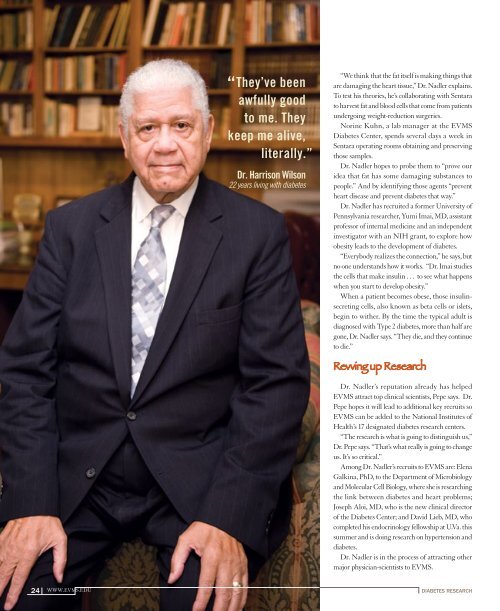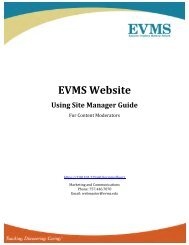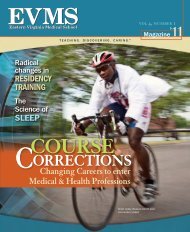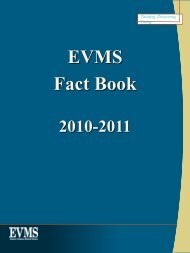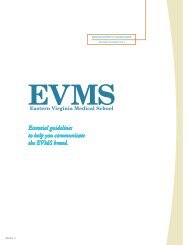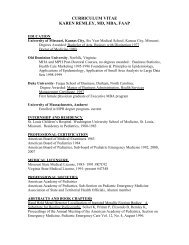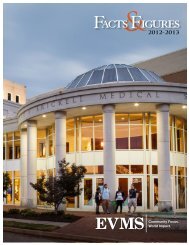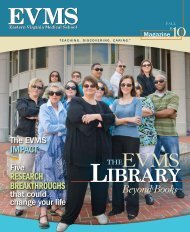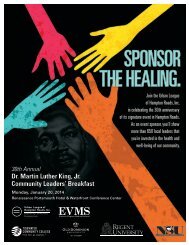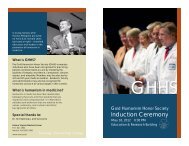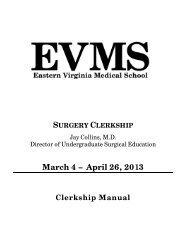in Hampton Roads in Hampton Roads - Eastern Virginia Medical ...
in Hampton Roads in Hampton Roads - Eastern Virginia Medical ...
in Hampton Roads in Hampton Roads - Eastern Virginia Medical ...
You also want an ePaper? Increase the reach of your titles
YUMPU automatically turns print PDFs into web optimized ePapers that Google loves.
“ They’ve beenawfully goodto me. Theykeep me alive,literally.”Dr. Harrison Wilson22 years liv<strong>in</strong>g with diabetes“We th<strong>in</strong>k that the fat itself is mak<strong>in</strong>g th<strong>in</strong>gs thatare damag<strong>in</strong>g the heart tissue,” Dr. Nadler expla<strong>in</strong>s.To test his theories, he’s collaborat<strong>in</strong>g with Sentarato harvest fat and blood cells that come from patientsundergo<strong>in</strong>g weight-reduction surgeries.Nor<strong>in</strong>e Kuhn, a lab manager at the EVMSDiabetes Center, spends several days a week <strong>in</strong>Sentara operat<strong>in</strong>g rooms obta<strong>in</strong><strong>in</strong>g and preserv<strong>in</strong>gthose samples.Dr. Nadler hopes to probe them to “prove ouridea that fat has some damag<strong>in</strong>g substances topeople.” And by identify<strong>in</strong>g those agents “preventheart disease and prevent diabetes that way.”Dr. Nadler has recruited a former University ofPennsylvania researcher, Yumi Imai, MD, assistantprofessor of <strong>in</strong>ternal medic<strong>in</strong>e and an <strong>in</strong>dependent<strong>in</strong>vestigator with an NIH grant, to explore howobesity leads to the development of diabetes.“Everybody realizes the connection,” he says, butno one understands how it works. “Dr. Imai studiesthe cells that make <strong>in</strong>sul<strong>in</strong> . . . to see what happenswhen you start to develop obesity.”When a patient becomes obese, those <strong>in</strong>sul<strong>in</strong>secret<strong>in</strong>gcells, also known as beta cells or islets,beg<strong>in</strong> to wither. By the time the typical adult isdiagnosed with Type 2 diabetes, more than half aregone, Dr. Nadler says. “They die, and they cont<strong>in</strong>ueto die.”Revv<strong>in</strong>g up ResearchDr. Nadler’s reputation already has helpedEVMS attract top cl<strong>in</strong>ical scientists, Pepe says. Dr.Pepe hopes it will lead to additional key recruits soEVMS can be added to the National Institutes ofHealth’s 17 designated diabetes research centers.“The research is what is go<strong>in</strong>g to dist<strong>in</strong>guish us,”Dr. Pepe says. “That’s what really is go<strong>in</strong>g to changeus. It’s so critical.”Among Dr. Nadler’s recruits to EVMS are: ElenaGalk<strong>in</strong>a, PhD, to the Department of Microbiologyand Molecular Cell Biology, where she is research<strong>in</strong>gthe l<strong>in</strong>k between diabetes and heart problems;Joseph Aloi, MD, who is the new cl<strong>in</strong>ical directorof the Diabetes Center; and David Lieb, MD, whocompleted his endocr<strong>in</strong>ology fellowship at U.Va. thissummer and is do<strong>in</strong>g research on hypertension anddiabetes.Dr. Nadler is <strong>in</strong> the process of attract<strong>in</strong>g othermajor physician-scientists to EVMS.24 www.eVMS.EDUdiabetes research


